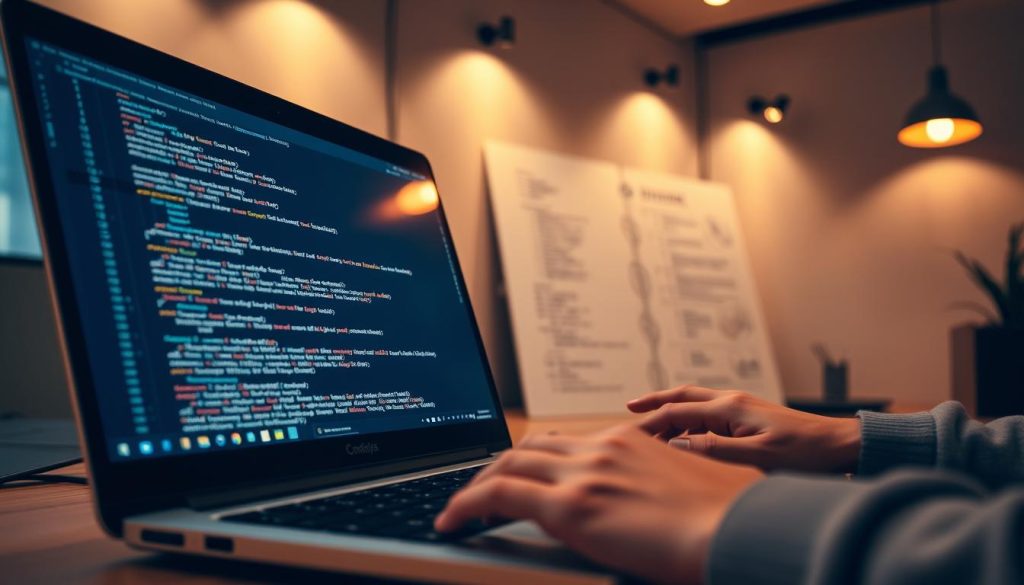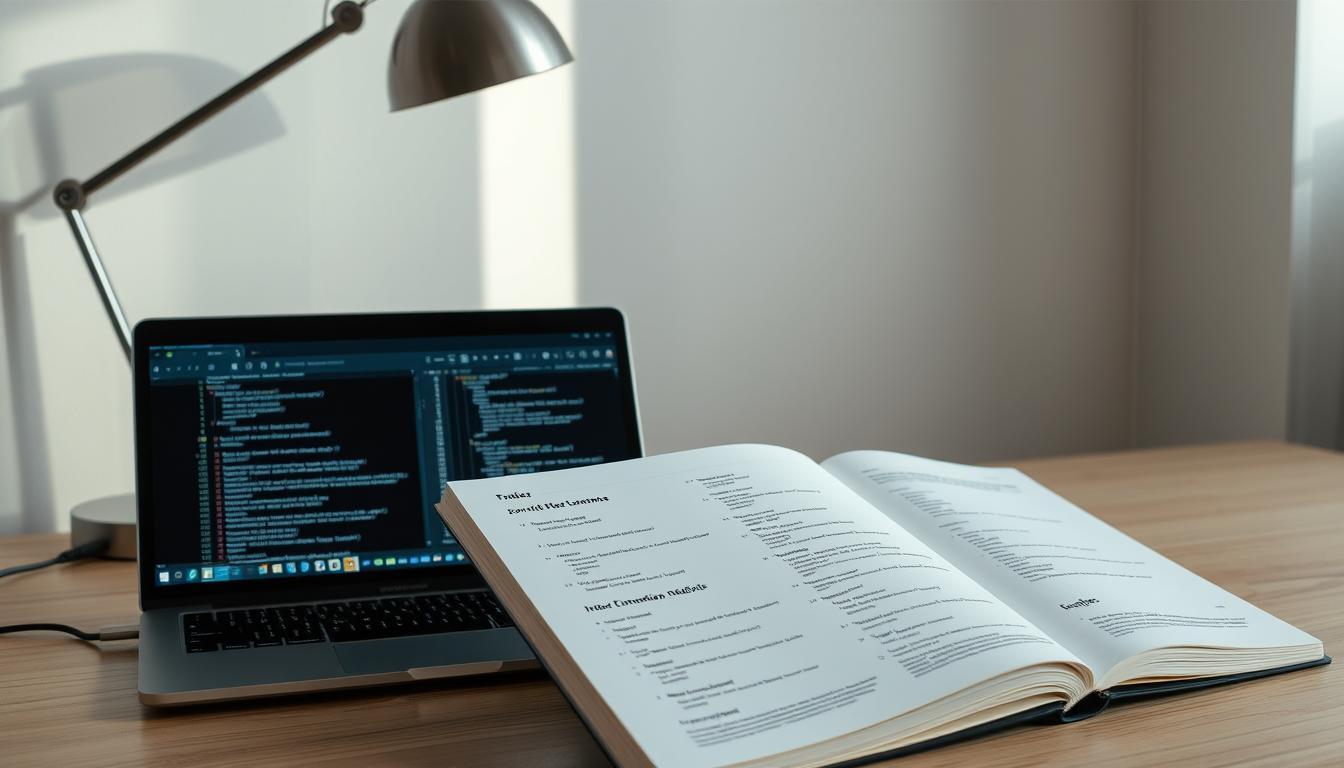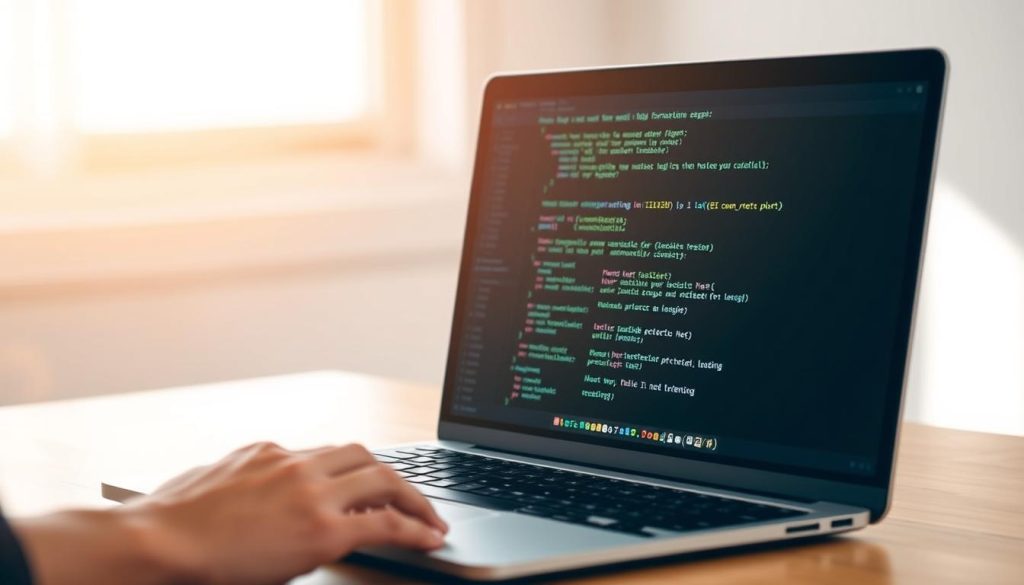Are you ready to unlock the world of programming with Python? As a beginner, taking the first step into coding can be both exciting and intimidating. But, with the right guidance, you can start building your own projects and exploring the vast possibilities that Python programming has to offer.
Python has become one of the most popular programming languages, and its simplicity makes it an ideal language for beginners to learn. Through this python coding tutorial step by step, you’ll gain a solid foundation in Python programming and be able to apply your skills in various fields, from data analysis to web development.
Key Takeaways
Table of Contents
- Understand the basics of Python programming
- Learn how to apply Python in real-world applications
- Get started with a python tutorial for beginners that’s easy to follow
- Discover the importance of Python in the industry
- Start your journey to becoming proficient in Python programming
Getting Started with Python
Embarking on your Python journey begins with a few straightforward steps to get you coding in no time. As part of our python step by step course, this section will guide you through installing Python, setting up your development environment, and running your first Python command.
Installing Python on Different Operating Systems
To start coding in Python, you first need to install it on your computer. The installation process varies slightly depending on your operating system.
Windows Installation Guide
For Windows users, download the latest Python version from the official Python website and follow the installation prompts, ensuring you check the box to add Python to your PATH.
Mac and Linux Installation
Mac and Linux users can install Python using package managers like Homebrew for Mac or apt-get for Linux, or by downloading the installer from the Python website.
Verifying Your Installation
After installation, verify Python is correctly installed by opening a terminal or command prompt and typing python –version.
Setting Up Your Development Environment
A well-configured development environment is crucial for efficient coding. This involves choosing a code editor or IDE and configuring your workspace.
Choosing a Code Editor or IDE
Popular choices for beginners include PyCharm, Visual Studio Code, and Sublime Text. These offer features like syntax highlighting and code completion.
Configuring Your Workspace
Create a dedicated folder for your Python projects and consider setting up a virtual environment for dependency management.
Running Your First Python Command
With Python installed and your environment set up, you’re ready to run your first Python command.
Using the Python Interactive Shell
Open a terminal or command prompt, type python to enter the interactive shell, and try simple commands like print(“Hello, World!”).
Creating and Running a Python Script
Create a file with a .py extension, write your Python code, and run it using python filename.py in your terminal or command prompt.
This concludes the initial steps of our beginner python coding lessons. You’re now set up to continue your Python journey, exploring more advanced topics in our python programming tutorial series.
Python Coding Tutorial Step by Step: Understanding the Basics
Mastering Python begins with understanding its basic syntax and features. As we explore the fundamentals, you’ll gain a solid foundation for more advanced concepts. Python’s simplicity and readability make it an ideal language for beginners.
Python Syntax and Indentation
Python’s syntax is designed to be intuitive and straightforward. One of its distinctive features is the use of indentation to define code structure.
The Importance of Proper Indentation
Proper indentation is crucial in Python. It denotes block-level structure, replacing the need for brackets or semicolons used in other languages. “Indentation is not just about aesthetics; it’s a syntactic requirement,” as emphasized by Python’s creator, Guido van Rossum.
Basic Syntax Rules
Python’s basic syntax rules are easy to learn. For instance, variables are assigned using the “=” operator, and comments start with the “#” symbol. Understanding these basics is key to writing clean, readable code.
Common Syntax Errors and How to Fix Them
Common syntax errors include incorrect indentation and missing colons after loop or conditional statements. To fix these, carefully review your code, and use Python’s error messages as a guide.
Variables and Data Types
Variables in Python are used to store data. Python supports various data types, including numeric types, text types, and boolean values.
Numeric Types (Integers, Floats)
Python has two primary numeric types: integers and floats. Integers are whole numbers, while floats represent decimal numbers. For example, x = 5 is an integer, and y = 3.14 is a float.
Text Type (Strings)
Strings are used to represent text. They can be enclosed in single quotes or double quotes. For instance, name = ‘John’ or message = “Hello, World!”.
Boolean Values
Boolean values represent true or false states. They are often used in conditional statements. For example, is_active = True or is_empty = False.
Comments and Documentation
Comments and documentation are vital for code readability and maintainability. They help explain the purpose and functionality of your code.
Single and Multi-line Comments
Single-line comments start with “#”, while multi-line comments are enclosed in triple quotes. For example, “””This is a multi-line comment”””.
Docstrings and Best Practices
Docstrings are used to document functions, classes, and modules. They provide a description of what the code does, its parameters, and its return values. Following best practices for docstrings enhances code readability and usability.
By mastering these basics, you’ll be well on your way to becoming proficient in Python programming. As you continue with this easy python coding tutorial, you’ll find that Python’s simplicity and flexibility make it an ideal language for a wide range of applications.
Working with Python Data Structures
Data structures are a critical component of Python programming, enabling developers to organize and manage data effectively. Python offers a variety of data structures, including lists, tuples, dictionaries, and sets, each with its unique characteristics and applications.
Lists and Tuples
Lists and tuples are two fundamental data structures in Python. Lists are denoted by square brackets [] and are mutable, meaning they can be modified after creation. Tuples, on the other hand, are defined by parentheses () and are immutable.
Creating and Accessing Lists
Creating a list in Python is straightforward. You can define a list by enclosing elements in square brackets. Accessing list elements is done using their index, starting from 0. For example: my_list = [1, 2, 3]; print(my_list[0]) outputs 1.
List Methods and Operations
Python lists support various methods and operations, such as append(), sort(), and extend(). These operations enable developers to manipulate lists efficiently. For instance, my_list.append(4) adds the element 4 to the end of my_list.
Understanding Tuples vs Lists
The primary difference between tuples and lists is their mutability. Tuples are used when data should not be changed, providing a layer of data integrity. Lists are used for dynamic data that may need to be altered.
Dictionaries and Sets
Dictionaries and sets are other essential data structures in Python. Dictionaries store data in key-value pairs, while sets are unordered collections of unique elements.
Working with Key-Value Pairs
In dictionaries, data is accessed using keys. For example: my_dict = {‘name’: ‘John’, ‘age’: 30}; print(my_dict[‘name’]) outputs ‘John’. This allows for efficient data retrieval and manipulation.
Common Dictionary Operations
Dictionaries support various operations, including adding new key-value pairs, updating existing values, and removing entries. For instance, my_dict[‘country’] = ‘USA’ adds a new key-value pair to my_dict.
String Manipulation Techniques
Strings in Python are immutable sequences of characters. Python provides several methods for string manipulation, including formatting and slicing.
String Methods and Formatting
Python offers various string methods like upper(), lower(), and split(). String formatting can be achieved using f-strings, which provide a readable way to embed expressions inside string literals.
String Slicing and Indexing
Strings can be sliced to extract substrings. For example: my_string = ‘Hello, World!’; print(my_string[0:5]) outputs ‘Hello’. This is useful for manipulating and analyzing string data.
Control Flow and Functions in Python
Understanding control flow and functions can significantly enhance your Python coding skills. Control flow statements determine the order in which your code is executed, while functions allow you to organize and reuse code.
Conditional Statements
Conditional statements are used to execute different blocks of code based on certain conditions. Python uses if, elif, and else for conditional statements.
Simple Conditions
A simple condition checks if a statement is true or false. For example: if x > 5: print(“x is greater than 5”).
Complex Conditions with Logical Operators
You can combine conditions using logical operators like and, or, and not. For instance: if x > 5 and y .
Nested Conditionals
Nested conditionals involve placing one conditional statement inside another. This can be useful for more complex decision-making processes.
Loops in Python
Loops allow you to execute a block of code repeatedly. Python supports for and while loops.
Iterating Through Sequences
You can iterate through sequences like lists or strings using a for loop. For example: for item in my_list: print(item).
Loop Control Statements
Loop control statements like break and continue help manage the flow of loops. break exits the loop, while continue skips to the next iteration.
Loop Patterns and Best Practices
Using loops efficiently involves understanding loop patterns and following best practices to avoid common pitfalls like infinite loops.

Creating and Using Functions
Functions are reusable blocks of code that perform a specific task. They are defined using the def keyword.
Function Definition and Parameters
A function definition includes the function name and parameters. For example: def greet(name): print(“Hello, ” + name).
Return Values
Functions can return values using the return statement. This allows you to use the result of a function in your code.
Function Documentation
Documenting your functions with docstrings helps other developers understand how to use your functions.
Importing and Using Modules
Python’s extensive library of modules can be imported into your code to provide additional functionality. For example, you can import the math module to use mathematical functions.
| Module | Description |
|---|---|
| math | Provides mathematical functions |
| random | Generates random numbers |
| statistics | Offers statistical calculations |
Building Your First Python Project
Now that you’ve grasped the basics of Python, it’s time to apply your knowledge to a real-world project. This step is crucial in your python coding tutorial step by step journey, as it helps solidify your understanding of the language.
Planning Your Project
Before diving into code, it’s essential to plan your project. This involves setting clear goals and breaking down the problem into manageable parts.
Setting Project Goals
Define what you want to achieve with your project. Are you building a simple calculator or a game? Having clear objectives will guide your development process.
Breaking Down the Problem
Once you have your goals, break down the project into smaller tasks. This could include data input, processing, and output for a calculator.
Step-by-Step Implementation
With a plan in place, start implementing your project. This involves writing the code, testing it, and refining your solution.
Writing the Code
Begin coding your project, following the plan you’ve laid out. Use your knowledge of Python syntax and data structures.
Testing and Debugging
As you write your code, test it regularly to identify and fix bugs. This iterative process is crucial for a successful project.
Refining Your Solution
After initial testing, refine your code to make it more efficient and user-friendly. This might involve optimizing algorithms or improving the user interface.
Project Ideas for Further Practice
To continue your python programming guide journey, consider projects like a to-do list app, a simple chatbot, or a data analysis tool. These projects will help you explore different aspects of Python programming.
| Project Idea | Description | Skills Learned |
|---|---|---|
| To-Do List App | Create a simple app to manage tasks | Data structures, file handling |
| Simple Chatbot | Develop a basic chatbot that responds to user input | String manipulation, conditional statements |
| Data Analysis Tool | Build a tool to analyze and visualize data | Data analysis libraries, visualization techniques |
Conclusion
Having completed this python tutorial for beginners, you’ve gained a solid foundation in Python programming. You’ve learned the basics, worked with various data structures, and even built your first project. Now, it’s time to take your skills to the next level by learning python coding online through interactive platforms and resources.
A python step by step course has equipped you with the knowledge to tackle more complex tasks. Continue practicing and exploring advanced topics, such as data analysis, machine learning, or web development, to expand your expertise.
To further enhance your learning experience, consider joining online communities, forums, or social media groups dedicated to Python programming. These resources will provide valuable support, guidance, and opportunities to network with fellow programmers.
Keep coding, and you’ll soon become proficient in Python. The world of programming is vast and exciting, and with persistence and dedication, you can achieve your goals and unlock new opportunities.

